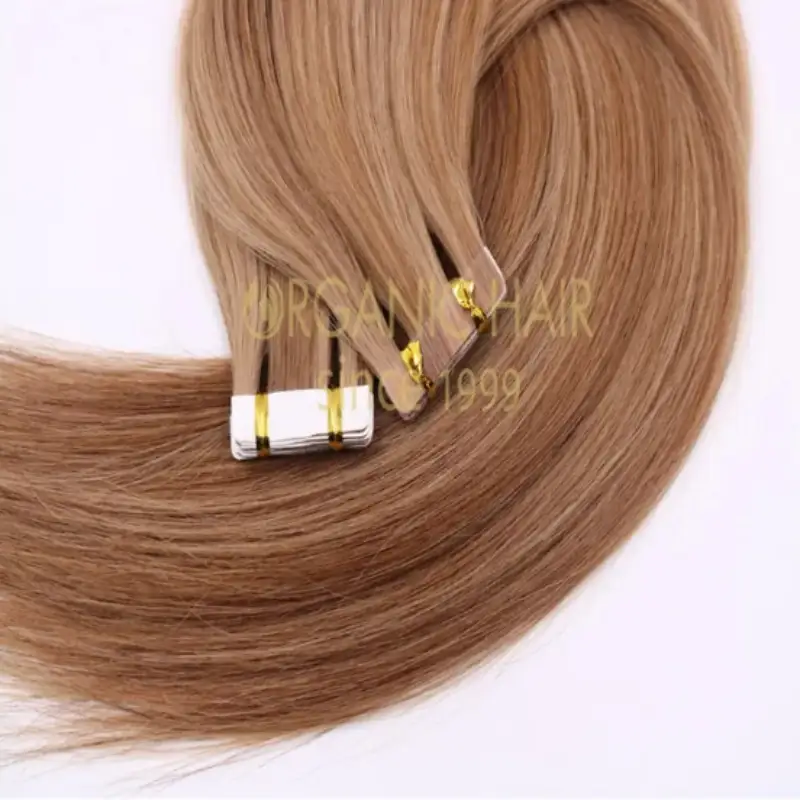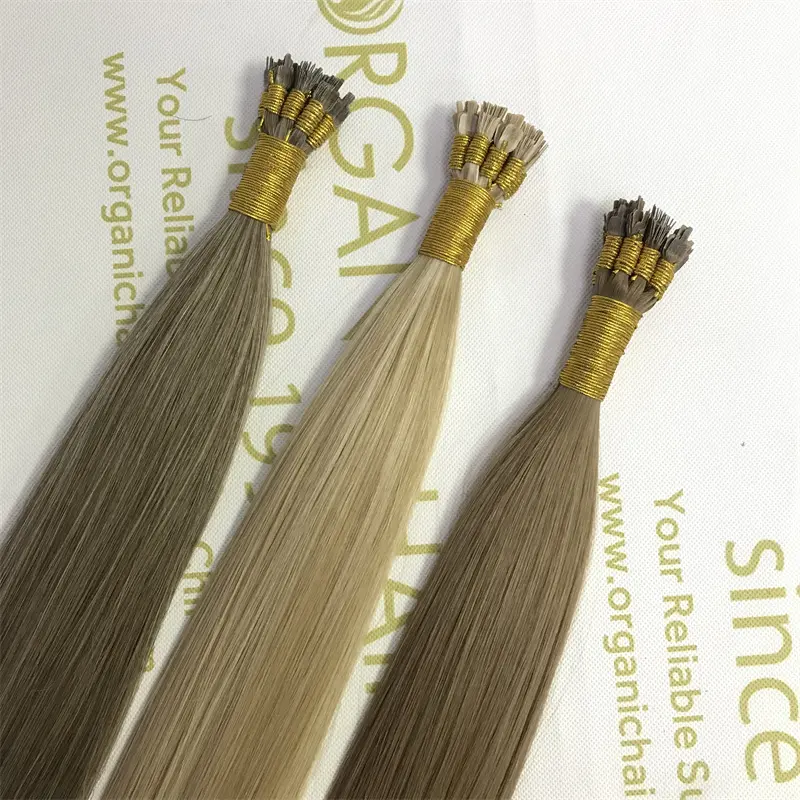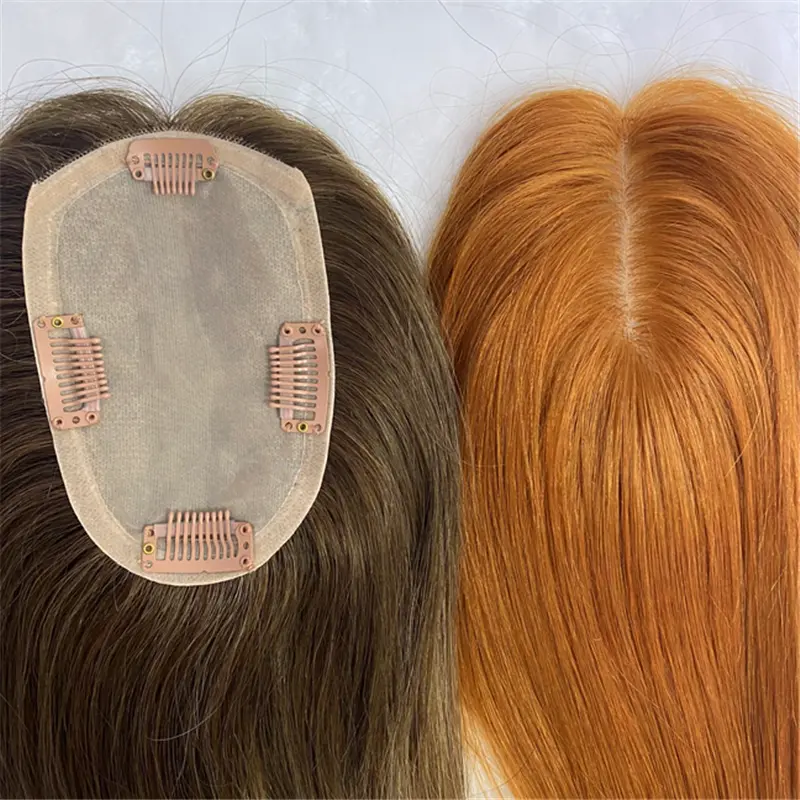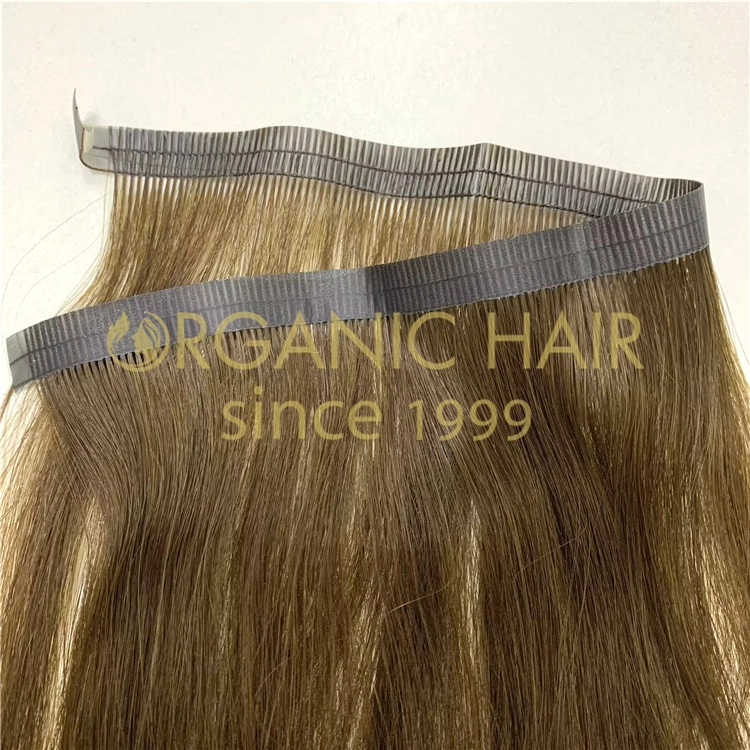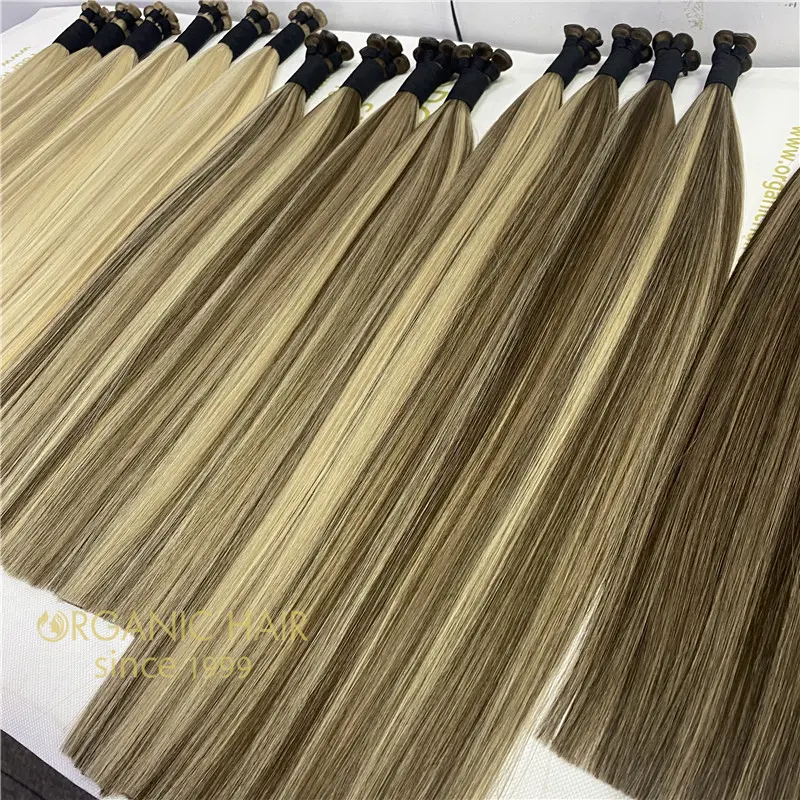Tape-in hair extensions are a semi-permanent method used to enhance hair length, volume, and thickness. They involve attaching thin, adhesive-backed wefts to sections of natural hair, creating a smooth and natural-looking blend. Because the tape lies flat against the scalp, these extensions are nearly invisible and feel lightweight, making them a popular choice among both stylists and clients.
What sets tape-in extensions apart is their balance between convenience and appearance. Unlike clip-ins, which are temporary and must be removed daily, tape-ins can last for several weeks with proper care. They are also less damaging than other semi-permanent options like fusion or glue-in extensions, as no heat or harsh chemicals are required during application. This makes them a suitable option for individuals with fine or fragile hair who still want the benefits of added length and volume.
Their popularity also stems from their versatility. Tape-in extensions can be styled just like natural hair, allowing users to curl, straighten, and even dye them (if using high-quality human hair). They are an excellent way to experiment with color or texture without making permanent changes to your own hair.
Despite their advantages, tape-in hair extensions do require regular maintenance and may not suit every lifestyle or hair type. The adhesive can weaken with exposure to oil-based products or excessive moisture, and repositioning is typically needed every 6–8 weeks.
This article explores the full picture—highlighting both the pros and cons of tape-in hair extensions. Whether you're considering them for a special occasion or looking for a long-term style solution, this guide will help you determine if tape-ins are the right fit for your needs and hair goals.
What Are Tape-In Hair Extensions?
Tape-in hair extensions are a semi-permanent method used to add volume, length, or thickness to natural hair. They are popular among hairstylists and clients for their natural appearance, lightweight feel, and relatively simple application process. Unlike clip-ins that are removed daily or more permanent methods like fusion extensions, tape-ins strike a middle ground, offering long-lasting results without extensive commitment or damage to the hair.
How They Work
The name “tape-in” comes from the method of application. Each extension piece consists of a thin, flat weft of hair with a pre-taped adhesive strip at the top. During installation, a small section of the natural hair is “sandwiched” between two tape-in wefts, securing it in place with gentle pressure. The adhesive is designed to be strong enough to hold the extension for several weeks while still being gentle on the natural hair when removed professionally.
This technique allows the extensions to lie flat against the scalp, making them virtually undetectable. The result is a seamless and natural look that blends effortlessly with your real hair.
Types of Hair Used
Tape-in extensions are available in both synthetic and human hair options, with key differences between the two:
Synthetic Hair: Made from plastic fibers, synthetic hair is usually more affordable. However, it lacks the softness, versatility, and natural movement of real hair. It also cannot be heat-styled or dyed, which limits your options.
Human Hair: Often referred to as Remy or 100% human hair, this is the preferred choice for most users. It offers a more natural look and feel, can be styled with heat tools, and dyed to match your preferred shade. Though more expensive, human hair tape-ins offer better longevity and a more realistic finish.
Lifespan and Maintenance
The average lifespan of tape-in hair extensions is 6 to 8 weeks before they need to be removed and re-applied. This is because your natural hair grows, causing the extensions to shift down and become more noticeable over time. However, the same hair extensions can often be reused up to 3–4 times with proper care and re-taping.
Maintenance is crucial to keeping tape-ins looking good and lasting longer. A few essential guidelines include:
Avoid oil-based products near the roots, as oils can weaken the adhesive bond.
Use sulfate-free shampoos and conditioners to prevent drying out the hair or damaging the adhesive.
Brush gently with a wide-tooth comb or extension-friendly brush to avoid tangling.
Dry thoroughly after washing to prevent mildew or slippage.
Regular salon visits for repositioning are necessary, usually every 6 to 8 weeks. During these appointments, the extensions are removed, cleaned, and re-taped before being re-installed closer to the roots.
Pros of Tape-In Hair Extensions
Tape-in hair extensions have quickly become a favorite among both professional stylists and clients who want to enhance their hair without committing to more invasive or damaging methods. From their natural appearance to their quick installation time, there are several compelling reasons to choose tape-ins. Below, we explore the major advantages in detail.
1. Natural Appearance
One of the most appealing benefits of tape-in hair extensions is how naturally they blend with your existing hair. Because the wefts are ultra-thin and flat, they lie flush against the scalp, making them virtually undetectable when installed correctly. The adhesive is clear and flexible, so there are no bulky clips or beads, and the hair can fall and move just like your natural strands.
This seamless blend makes tape-ins ideal for those looking for an understated enhancement. Whether you're adding length, volume, or both, the extensions are designed to look like they’re part of your natural hair, even when styled up or down.
2. Comfortable to Wear
Unlike clip-in extensions, which can feel heavy or cause discomfort after a few hours, tape-ins are incredibly lightweight. Their flat design puts minimal strain on the roots and scalp, making them a more comfortable choice for everyday wear. Most users report that they barely feel the extensions once they’re installed, and since there’s no hardware involved, there’s nothing poking or pulling at your scalp.
This comfort factor makes tape-ins especially suitable for those with finer hair or sensitive scalps.
3. Quick Application
Another standout benefit of tape-in extensions is the speed of application. A full head of tape-ins can typically be installed in 45 minutes to an hour, depending on the amount of hair being applied. This is significantly faster than other semi-permanent methods like sew-ins or fusion extensions, which can take several hours.
For people with busy schedules, the quick salon time is a major plus. It also makes tape-ins a convenient choice for special occasions like weddings or photoshoots when time is limited but you still want to elevate your look.
4. Reusable
One of the most cost-effective advantages of tape-in extensions is that they are reusable. With proper care and maintenance, the same set of human hair extensions can be reused multiple times. After each 6–8 week wear cycle, the extensions can be removed, cleaned, re-taped, and re-installed by your stylist.
This makes them an economical option in the long run, especially if you invest in high-quality Remy human hair.
5. Less Damage Compared to Other Methods
Tape-in extensions are considered one of the least damaging semi-permanent extension methods. The installation process involves no heat, glue, or harsh chemicals, which helps preserve the health and integrity of your natural hair. Since the extensions lie flat and distribute weight more evenly than other methods, they’re also less likely to cause breakage or stress at the roots.
Of course, proper application and care are still essential to avoid damage, but overall, tape-ins are a gentle and hair-friendly option.
6. Great for Volume and Length
If you're dreaming of fuller, longer hair, tape-in extensions deliver instant results. Whether you're recovering from a haircut you regret or simply want to add more body to your current style, tape-ins allow for a fast and dramatic transformation.
They can be customized to match your hair color and layered to suit your desired length and thickness, giving you a completely personalized look. This makes them a popular choice for anyone wanting to enhance their appearance without waiting months or years for natural growth.
In short, tape-in hair extensions offer a versatile, low-maintenance, and natural-looking solution for enhancing your hairstyle. Their ease of use, comfort, and reusability make them a top choice for anyone looking to boost their hair game with minimal hassle.
Cons of Tape-In Hair Extensions
While tape-in hair extensions offer many benefits—like a natural look, lightweight feel, and reusability—they’re not without their drawbacks. As with any beauty investment, it’s important to consider both sides before deciding if they’re right for your lifestyle and hair type. Below are the most common cons of tape-in hair extensions, along with what you should know before getting them installed.
1. Regular Maintenance Required
One of the biggest commitments with tape-in hair extensions is the ongoing maintenance they require. Unlike temporary options like clip-ins, tape-ins need to be repositioned every 6 to 8 weeks as your natural hair grows. If left too long, the adhesive bonds can start to slip, become visible, or cause tangling near the roots.
In most cases, repositioning and reapplication should be done by a professional stylist to ensure the extensions stay properly aligned and don’t damage your hair. This means making regular salon visits, which can be time-consuming and add to the long-term cost.
2. Can Slip or Tangle
While properly installed tape-ins are secure, slippage can happen—especially if they aren’t cared for correctly. Using oil-based hair products, applying heavy conditioners near the roots, or even brushing too roughly can weaken the adhesive and cause the wefts to slip out or shift position.
Additionally, if the extensions are not brushed and maintained regularly, the adhesive areas and your natural hair can tangle. This is particularly a concern for those with fine or curly hair, where knots can form more easily around the tape area.
3. Limited Styling Options
Although tape-ins offer a fairly natural range of motion, styling can be a bit limited, especially when it comes to products and tools. Oil-based serums and conditioners must be avoided near the roots, as they can break down the adhesive and cause the extensions to come loose.
Heat styling is also possible, but you’ll need to be cautious around the tape bonds. Excessive heat too close to the adhesive can weaken the glue or cause it to melt slightly, which may lead to slippage or discomfort. Updos and high ponytails may also expose the tape tabs, depending on how the extensions were placed.
4. Initial Cost
While tape-in extensions can be reused several times, the initial investment can be significant. The cost of high-quality human hair extensions is often high, and the professional application adds to the expense. Depending on the brand, hair length, and stylist fees, a full set can cost several hundred dollars.
While it may be more affordable over time if reused properly, the upfront price can be a deterrent for those on a tight beauty budget.
5. Not Ideal for Very Active Lifestyles
If you exercise frequently, sweat a lot, or swim often, tape-in extensions may not be the most practical choice. Sweat, water, and heat can affect the strength of the adhesive, potentially causing slippage or reducing the longevity of the bond.
For swimmers or athletes, constant exposure to moisture can also lead to tangling, and the extensions may require more frequent repositioning. In these cases, a more temporary or clip-in option might be more suitable.
While tape-in hair extensions offer many impressive benefits, they do require a level of commitment in terms of upkeep, cost, and styling care. If you're someone who prefers a low-maintenance routine or leads a highly active lifestyle, these potential drawbacks are worth considering.
Ultimately, the decision comes down to your personal preferences, hair goals, and how much time and effort you’re willing to invest in maintaining your extensions. By understanding the cons ahead of time, you can make a more informed, confident choice.
Who Are Tape-In Extensions Best For?
Tape-in hair extensions are a great option for many people, but they’re not ideal for everyone. Knowing whether they’re right for your hair type and lifestyle is key to getting the best results and maintaining healthy hair.
These extensions work especially well for people with fine to medium hair. Because the wefts are ultra-thin and lay flat against the scalp, they blend seamlessly with finer hair textures without looking bulky or obvious. Unlike clip-ins or bulky sew-ins, tape-ins are less likely to weigh down delicate strands or cause stress at the roots, making them a gentle yet effective way to add volume and length.
They’re also ideal for those seeking a semi-permanent solution that doesn’t involve long-term commitment. Tape-ins can last six to eight weeks at a time and are reusable with proper care. This makes them perfect for individuals who want something longer-lasting than clip-ins but don’t want to commit to permanent methods like fusion or micro-links.
However, tape-in extensions are not recommended for people with very short or extremely oily hair. If your hair is too short, the tapes may be difficult to hide and won’t blend properly. Similarly, if your scalp produces a lot of natural oil, the adhesive may not hold as well, leading to slippage or reduced wear time.
In short, tape-in extensions are best suited for those with enough natural length to conceal the wefts, a low to moderate oil production on the scalp, and a desire for a medium-term solution that looks and feels natural. If that sounds like you, tape-ins might be the perfect match.
Tips for Caring for Tape-In Extensions
Proper care is essential for keeping your tape-in hair extensions looking great and lasting as long as possible. With the right routine, you can extend the life of your extensions and maintain their seamless blend with your natural hair. Here are some key tips to follow:
Washing & Brushing
When washing your hair, use sulfate-free, gentle shampoos and conditioners to avoid drying out the extensions or weakening the adhesive. Focus shampoo on the scalp, and keep conditioner away from the roots and tape tabs—applying it only from mid-length to ends. Avoid vigorous scrubbing near the bonds.
Before washing, gently brush your hair with a loop brush or wide-tooth comb to remove tangles. Always brush starting at the ends and work your way up, holding the hair at the roots to reduce pulling on the tape bonds.
Products to Avoid
Avoid oil-based, alcohol-based, or silicone-heavy products near the roots, as they can break down the adhesive and cause slippage. This includes certain dry shampoos, serums, and deep conditioners. Stick to lightweight, extension-friendly styling products whenever possible.
Nighttime Care
To protect your tape-in extensions while you sleep, loosely braid your hair or tie it in a low ponytail to prevent tangling. Sleeping on a silk or satin pillowcase can also reduce friction and keep both your natural hair and extensions smoother and less frizzy.
Never go to bed with wet hair, as this can cause tangling and stress on the adhesive. Make sure your hair is completely dry before sleeping to avoid damage or matting.
With consistent, gentle care, your tape-in extensions can stay beautiful and reusable for multiple applications.
Conclusion
Tape-in hair extensions offer a natural, lightweight solution for adding volume and length to your hair without permanent changes. The benefits, such as a seamless blend with natural hair, comfort, and quick application, make them an attractive option for many people. They are also reusable and less damaging compared to other semi-permanent methods, providing great flexibility for styling and maintenance.
However, they do require regular maintenance, as they need repositioning every 6-8 weeks, and there are some limitations when it comes to styling and product use. Tape-ins may not be ideal for very short or oily hair types, and the initial investment can be higher than other options.
Ultimately, choosing tape-in extensions depends on your hair goals, lifestyle, and commitment level. If you're looking for a semi-permanent solution that offers volume and length without excessive upkeep, tape-ins could be the perfect fit.
To ensure the best results and hair health, it’s always recommended to consult with a professional stylist. They can help assess your hair type and give expert advice on whether tape-ins are the right choice for you.
